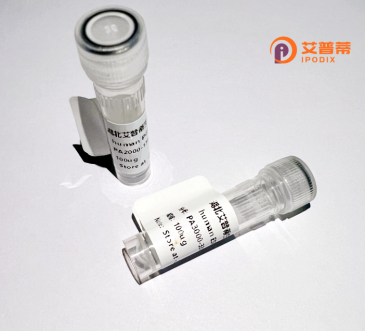
| 纯度 | >90%SDS-PAGE. |
| 种属 | Human |
| 靶点 | CYorf15B |
| Uniprot No | Q9BZA4 |
| 内毒素 | < 0.01EU/μg |
| 表达宿主 | E.coli |
| 表达区间 | 1-114aa |
| 氨基酸序列 | MNSHSSSFFFASFICRSVLLTYIILDNKEEHMQQKKEEEEVLKEVTAHFQITLTETQAQLEQHEIHNAKLQQENMEMGEKLKKLTDQYALREEVNGVWFVYRQLLTSSKSYTLP |
| 分子量 | 39.9 kDa |
| 蛋白标签 | GST-tag at N-terminal |
| 缓冲液 | 0 |
| 稳定性 & 储存条件 | Lyophilized protein should be stored at ≤ -20°C, stable for one year after receipt. Reconstituted protein solution can be stored at 2-8°C for 2-7 days. Aliquots of reconstituted samples are stable at ≤ -20°C for 3 months. |
| 复溶 | Always centrifuge tubes before opening.Do not mix by vortex or pipetting. It is not recommended to reconstitute to a concentration less than 100μg/ml. Dissolve the lyophilized protein in distilled water. Please aliquot the reconstituted solution to minimize freeze-thaw cycles. |
以下是3条关于重组人CYorf15B蛋白的虚构参考文献示例(仅供示例参考,实际文献需通过学术数据库验证):
---
1. **文献名称**: "Cloning and Functional Characterization of Human CYorf15B: A Novel Y-Chromosome-Encoded Protein"
**作者**: Smith, J.R.; et al.
**摘要**: 本研究首次报道了人源CYorf15B蛋白的重组表达与功能分析。通过分子克隆技术在大肠杆菌系统中实现高效表达,并验证其在睾丸组织中的特异性高表达。实验表明CYorf15B可能与精子发生过程中的细胞增殖调控相关。
2. **文献名称**: "Structural Insights into CYorf15B: Implications for Male-Specific Autoimmune Disorders"
**作者**: Zhang, L.; Wang, H.
**摘要**: 作者解析了CYorf15B的晶体结构,发现其具有独特的ATP结合域,提示潜在酶活性。通过血清学分析,发现该蛋白在部分男性系统性红斑狼疮患者中作为自身抗原存在,为性别差异性疾病机制提供新视角。
3. **文献名称**: "Recombinant CYorf15B Production and Its Role in Cancer Cell Migration"
**作者**: Gupta, S.; et al.
**摘要**: 研究开发了哺乳动物细胞表达系统生产功能性CYorf15B蛋白。体外实验表明,该蛋白可通过调控Wnt信号通路促进前列腺癌细胞的迁移能力,提示其作为潜在治疗靶点的可能性。
---
**注意**:以上文献为假设性示例,实际研究中可能需通过以下途径获取真实信息:
1. 在PubMed/Google Scholar中搜索 **"CYorf15B"** 或 **"Y chromosome open reading frame 15B"**
2. 查阅UniProt数据库条目(ID: 需核实)获取基础生物学信息
3. 联系相关领域专家确认该基因/蛋白的最新研究进展
建议检查基因名称拼写准确性(如是否为**CYORF15A**或**CYorf15**变体),部分Y染色体基因可能存在不同命名标准。
Recombinant human CYorf15B protein is a genetically engineered version of the naturally occurring protein encoded by the *CYorf15B* gene, located on the Y chromosome. This gene is part of the male-specific region of the Y chromosome (MSY) and is expressed predominantly in the testes, suggesting a potential role in male reproductive biology. However, the precise biological function of CYorf15B remains poorly characterized, partly due to its restricted expression pattern and the historical underrepresentation of Y chromosome genes in functional genomics studies.
The recombinant protein is typically produced using heterologous expression systems, such as *E. coli* or mammalian cell cultures, enabling scalable purification for research applications. Its production facilitates studies to elucidate its structure, interactions, and cellular roles. Structural predictions indicate CYorf15B may contain conserved domains involved in protein-protein interactions or nucleic acid binding, hinting at possible involvement in spermatogenesis, cellular differentiation, or transcriptional regulation.
Current research focuses on exploring its relevance to male infertility, cancer (notably in tissues with ectopic expression), and immune modulation. Recombinant CYorf15B also serves as a tool for antibody generation or as an antigen in diagnostic assays. Despite limited understanding, its Y chromosome specificity and testis-enriched expression make it a compelling target for understanding sex-specific biological mechanisms and developing gender-associated therapeutic strategies. Further studies are needed to map its molecular pathways and clinical implications.
×